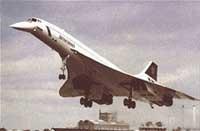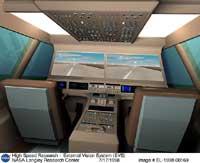Aircraft: Supersonic Epoch
More and more passengers, more aircraft, more competition between flight companies... therefore, more and more cheaper and faster travel. As a result, year after year, aircraft circulation records are broken. However, it seems that the current planes have reached the border, they cannot be more comfortable and faster. Therefore, supersonic aviation research has recovered. What else can be asked of current aircraft if there is no more speed and more security?
Aeronautical companies are working on this, but they have found large economic investments, perhaps excessive for private companies. In the first car of this line of research are Europe and the United States. No one wants to lose the train. In fact, the first to get good results, in addition to high-level technology, is done with the passenger aircraft market.

The future will be the supersonic plane. However, the road is not easy. These aircraft must be fast, efficient, safe and, above all, do not harm the environment. The supersonic passenger plane in Europe, Concorde, has failed in this last obligation. And, among other things, that is why he has not been able to make the leap to other markets. Current technology, however, is able to correct Concorde errors, air pollution and acoustics. Just put it in place.
US Intentions
Heaven and sky technology have so far been the most American. Boeing, McDonnel Douglas, Lockhed Martin, etc. are aviation leaders. American flight companies are also the most powerful in the world, the ones that carry the most passengers each year. But they have also begun to compete. An example? Airbus Europe.
Faced with this situation, the Americans turned to the future and began to investigate supersonic planes. New structures and materials, innovative designs, propulsion systems that do not harm the environment… were present on the daily agenda of American researchers. On the day of its development there will be no impediment to start the construction of the plane itself. Enter NASA. The space agency launched the HSR (High Speed Research) program in 1990. The aim of the program is to investigate to build a supersonic plane.

NASA commissioned companies Boeing and McDonnell Douglas to study the demand for passenger supersonic aircraft service. The results of the report were excellent, with an increase of transoceanic travelers over 200%. This means that between 2005 and 2015 there would be a market for more than 500 supersonic aircraft. But the report also clarified more: demand would be generated, but if the planes did not spoil the atmosphere, if they were not noisy, and were similar to the last generation subsonic planes.
Once the results of the report were known, the HSR program accelerated. Boeing and McDonnell Douglas worked on aerodynamic aircraft designs capable of moving 300 passengers at a speed of 2.4 times Mach sound. In parallel, other companies embarked on the development of engines with the aim of not damaging power and the environment.
The program includes the construction of the first prototypes for 2001 and the first flights for 2005. However, it seems that the issue has cooled down. NASA's budget for aeronautical research dropped considerably last year and now no one knows when the United States will be willing to supersonic passenger aircraft. Technological objectives are maintained but it is not known whether they will be implemented.
And what in Europe?
In view of American efforts, Europe also works in the field of supersonic aircraft. Perhaps more rightly, because it is increasingly clear that the Concorde will not succeed. The Concorde has also been shortlisted in 2010. Being the first supersonic passenger plane, the design of the Concorde was not very brave, so it is heavy and expensive. Concorde maintenance is four times more expensive than the Boeing 747.
Several European companies collaborate on the ESRP (European Supersonik Research Program) program: Rolls-Royce, Aerospatiale, Daimler-benz, Aerospace, British Aerospace, SNECMA, etc. The project they have worked with all these companies is very similar to the American project: Capacity for 250 passengers and speed of Mach 2. The downside is that technology is too expensive and still not among the priorities of European countries.
It is not yet clear whether there will be enough money to fund such projects, but everything points to the future of passenger planes being a supersonic surname. If we move on that path, we also have to start thinking about a supersonic future. Some have already begun to think about it, such as the X-30 NASP, but the truth is that the first step has not yet been completed. But it's not science fiction, it's a matter of time.
Published in 7
Buletina
Bidali zure helbide elektronikoa eta jaso asteroko buletina zure sarrera-ontzian










